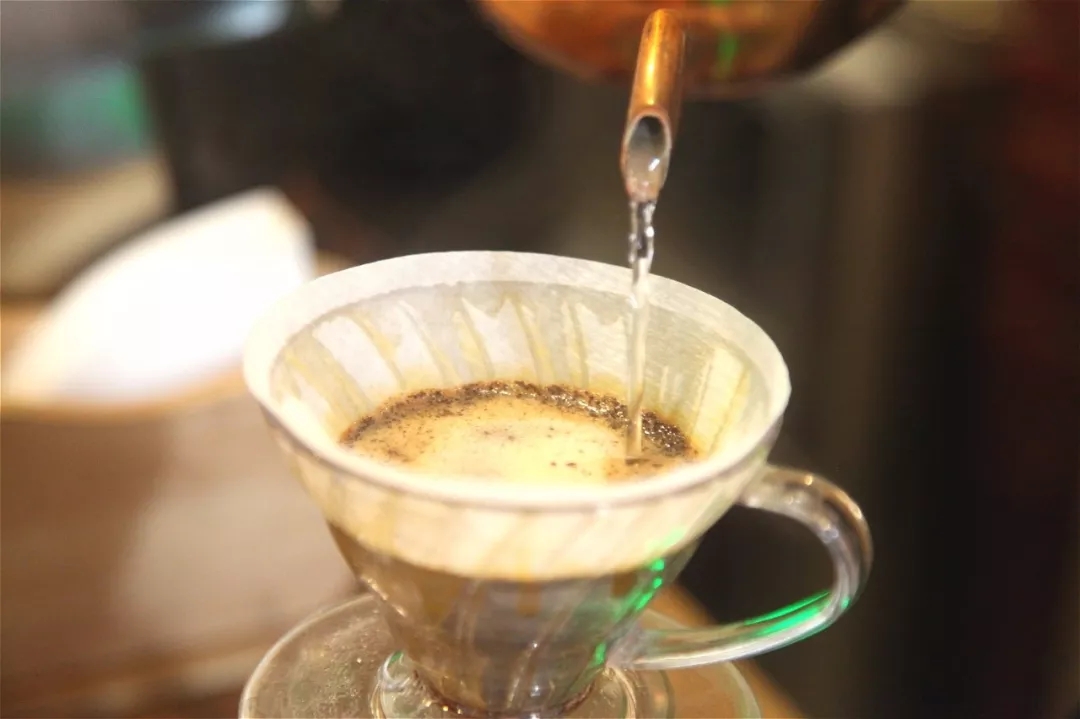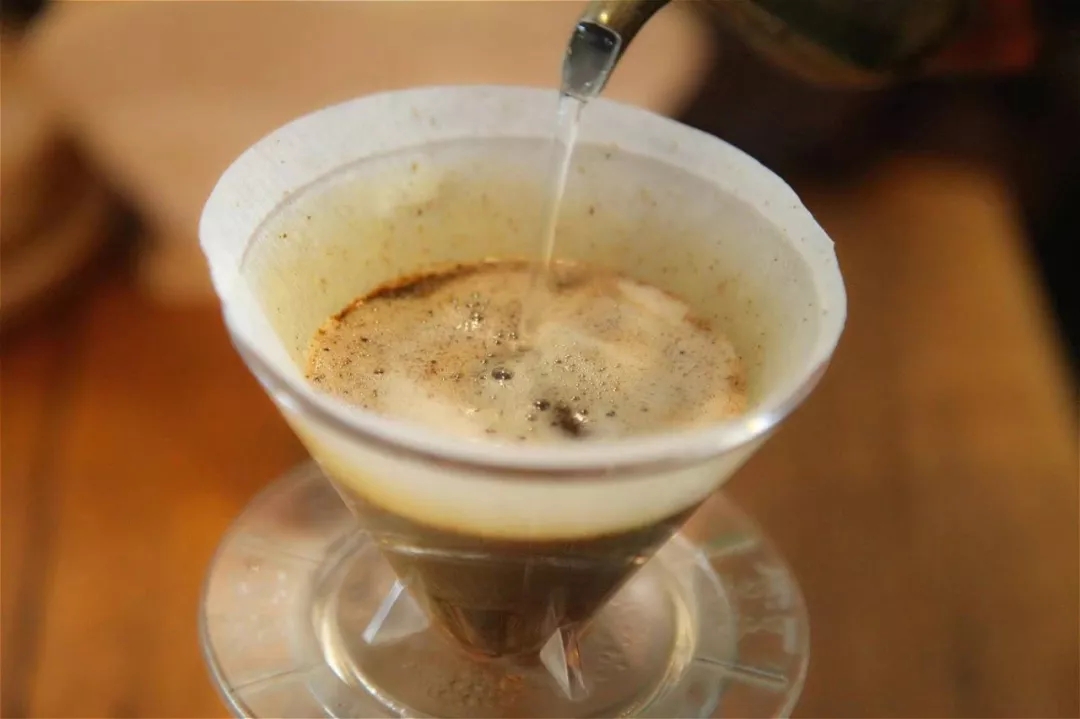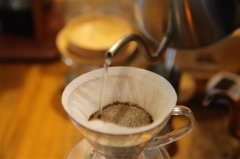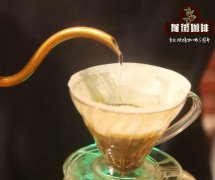Which one should I choose to make the coffee filter cup by hand? The filter cup is different. Do you want to change the hand punching parameters?
We usually have three kinds of filter cups: tapered filter cup, trapezoidal filter cup and flat-bottomed filter cup.

As we all know, the speed at which the water level falls will affect the time for coffee powder to soak in water, and the fan-shaped filter cup improves this factor by deepening the depth of the ribs, that is, by increasing the exhaust effect; another way is to change the shape of the filter cup to increase the concentration of water, and the conical filter cup arises at the historic moment.
And the coffee brewed with different filter cups is quite different in flavor, naturally, there will be some differences in brewing techniques. Today, the editor will take a look at different filter cups when brewing, what should be paid attention to, or what suitable techniques are there?
| | tapered filter cup |
The wide and narrow design of the tapered filter cup can not only increase the concentration of water flow, but also make the coffee powder more concentrated. During the initial water injection and steaming, the coffee powder will be easier to absorb water evenly. The more representative conical filter cups are V60 filter cup and KONO filter cup.
V60 filter cup

The most distinctive features of the V60 filter cup are probably the spiral grooves and the large water holes at the bottom. The design of the spiral groove of the filter cup can make the flow velocity more uniform, but because of the tapered design, the powder layer is thicker in the middle and thinner around, which can easily lead to over-extraction of some coffee powder and insufficient extraction of some coffee powder; the design of the large round hole in the center can increase the flow rate and make up for the non-uniformity of extraction to a certain extent. It also requires some cooking skills and stability when using V60 filter cup.

When cooking with a V60 filter cup, you can use a large flow of water to flush quickly, or the central injection of water to cook.
The spiral groove on the edge of the filter cup just acts as a diversion, extending from the bottom to the top, and the exhaust effect is relatively smooth; the curved ribs increase the flow path to increase the contact time between coffee powder particles and water, and the large outlet at the bottom can also increase the flow rate, so you don't have to worry about water accumulation in the filter cup even when cooking with large water flow.

As we said earlier, due to the problem of the design of the filter cup, the powder layer in the middle will be thicker and the surrounding will be thinner, so we can use the central water injection method to cook.
Due to the fast flow rate of V60 filter cup, it is easy to be delaminated in the process of extraction, so it is easy to show multi-level aroma, and the flavor levels are changeable. Coffee will have rich acid changes from hot to cold, and the taste is clear and transparent.
KONO filter cup

A closer look at the ribs of the KONO filter cup shows that the ribs of the KONO do not extend from the bottom to the top, but stop when they are less than half the height of the filter cup. This height is designed to ensure that during the dripping process, the filter paper can be attached to the wall of the filter cup after absorbing water, and once the exhaust space is limited, the air flow will be limited, which will increase the water absorption time of coffee powder particles.

In the extraction process of KONO filter cup, the pressure produced by siphon effect is used for extraction, so the extraction degree of water saturation and concentration of coffee powder particles in the initial stage will be much higher.
KONO filter cup will be more suitable for volcanic flushing, drip method, such as partial Japanese punching method.

The drip method mainly extracts the coffee with high concentration in the front stage. During the dripping process, the coffee powder particle layer on the surface will slowly bulge, which is the same as the coffee powder exhaust and pushing before, when the powder layer expands continuously, the coffee powder particles absorb more water, and when it reaches saturation, the water will slowly accumulate at the bottom, and when it accumulates to a certain extent, the air will be squeezed. A small extraction water column will be produced. To produce pneumatic extraction.

When a small water column is produced by a drop method using a KONO filter cup, in order to maintain the pneumatic extraction, it is necessary to supply water until the water level reaches a little more water in the upper ribs, so that the filter paper can be closely attached to the filter cup wall, preventing the air from flowing upward, creating a relatively airtight space, because the upward passage is blocked, and the water can only flow to the filter paper and ribs. At this time, the internal water will continue to be pushed down. Until the production of pneumatic extraction water column, until the flow of water, so the key to the use of KONO filter cup is to keep the water supply above the ribs, so that the pneumatic extraction of KONO can be produced.

The flow rate of the KONO filter cup is slow, the sweetness of the coffee will be more obvious, the taste is easy to go to the rich direction, the overall extraction is more uniform, and the aroma is introverted. The editor thinks that the beans used for medium and deep baking are very good!
| trapezoidal filter cup

The earliest Melita trapezoidal filter cup was designed with only one hole at the bottom, but its disadvantage was that when the coffee was filtered, the hole was often blocked by fine powder, which made the coffee soaked in the water for too long and made the coffee bitter. Therefore, the brewing method of adding water was adopted for this kind of filter cup, in the hope that the coffee particles could always float on the surface, but the relative trouble was that the coffee particles were soaked in the water for a long time. It will affect carbon dioxide emissions and reduce the extraction rate, so a three-hole Kalita trapezoidal filter cup will be derived later.

Viewed from the side, the shape is wide at the top and narrow at the bottom, which is conducive to the concentration of water, while the top is round. The purpose of making a wider area is to make the coffee particles evenly distributed and reduce the stacking condition. There are many ribs on the wall of the kalita cup, distributed in a straight line, and the distance between the ribs is the same, in order to increase the speed of exhaust and flow. At the same time, its flow rate is relatively slow, and it is mainly extracted by soaking.

As the kalita trapezoidal filter cup because there are three small round holes at the bottom, the flow out is relatively slow, so the whole process is semi-immersion extraction, which is relatively friendly for beginners, because the filter cup can easily help you to achieve full extraction, without worrying about insufficient extraction caused by excessive water flow. When using the Kalita filter cup, the amount of coffee powder, grinding thickness and brewing water temperature need to be adjusted in detail, such as medium grinding (crude salt size), the water temperature is not too high.
| | flat bottom filter cup |
Our common Kalita Wave cake filter cup belongs to the flat bottom filter cup. The flat-bottomed design allows coffee to be extracted more fully. If you take a closer look at the Kalita cake filter cup, you will see that there are three small holes in the flat bottom. Similar to the trapezoidal filter cup, the cake filter cup is mainly soaked. Although the aroma and flavor change of the cake cup is not as strong as that of the cone filter cup, the overall flavor of the beans and the solid taste and sweetness of the mouth are all good.

For Kalita, hot water should be injected directly into the center, and try not to inject water along the edge, so that the water will flow directly through the gap between the filter paper and the filter cup.

The flow rate of kalita cake filter cup is slow, it is easy to bring out the sweetness of coffee, the flavor is balanced, and the taste is easy to go in a rich direction.

The editor thinks that if you want to get coffee with clear taste, obvious flower and fruit aroma and rich layers, you might as well try the V60 filter cup; if you want the coffee to be full-bodied, try the KONO filter cup. If you want to be balanced and stable, then trapezoidal filter cup and flat bottom filter cup are both good choices. After all, the design of each filter cup has its own unique characteristics. We can also choose which coffee filter cup to brew according to the characteristics of beans or the flavor we want.
Important Notice :
前街咖啡 FrontStreet Coffee has moved to new addredd:
FrontStreet Coffee Address: 315,Donghua East Road,GuangZhou
Tel:020 38364473
- Prev

Why does the hand steam do not swell? Why should hand-made coffee be steamed?
Professional coffee knowledge exchange more coffee bean information Please follow the coffee workshop (Wechat official account cafe_style) recently fans often ask the editor why his own steaming can't make hamburgers. Have you been cheated by the store to buy stale beans? Well, it's true that the freshness of beans will affect steamed hamburgers, but it's not the only reason! The editor is now
- Next

Mocha coffee maker simple tutorial mocha coffee pot experience how to make a cup of mocha coffee
Professional coffee knowledge exchange more coffee bean information Please follow the coffee workshop (Wechat official account cafe_style) the use of the mocha coffee pot is very simple, but the brewing process is still bitter, too strong, lack of flavor from time to time. Today, the seniors share their experience in using the mocha pot, hoping to enable players of the mocha pot to master the mocha pot more accurately, cup by cup.
Related
- Beginners will see the "Coffee pull flower" guide!
- What is the difference between ice blog purified milk and ordinary milk coffee?
- Why is the Philippines the largest producer of crops in Liberia?
- For coffee extraction, should the fine powder be retained?
- How does extracted espresso fill pressed powder? How much strength does it take to press the powder?
- How to make jasmine cold extract coffee? Is the jasmine + latte good?
- Will this little toy really make the coffee taste better? How does Lily Drip affect coffee extraction?
- Will the action of slapping the filter cup also affect coffee extraction?
- What's the difference between powder-to-water ratio and powder-to-liquid ratio?
- What is the Ethiopian local species? What does it have to do with Heirloom native species?

